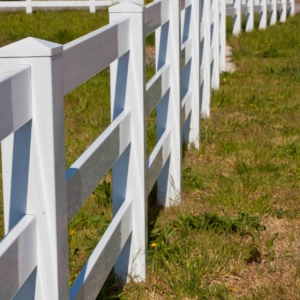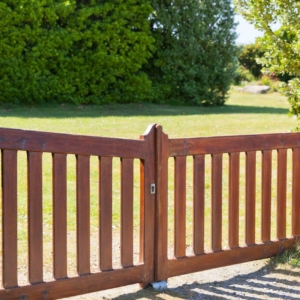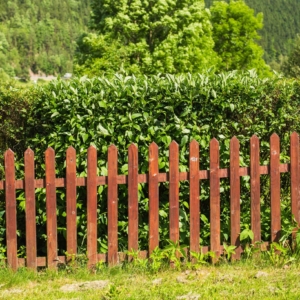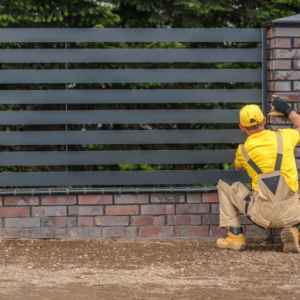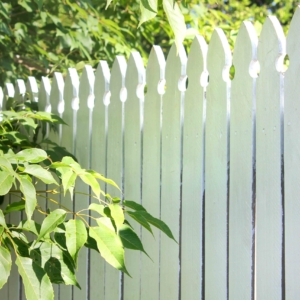Fences
We offer a variety of fences, including treated pine pickets and cedar pickets. However, if you're here, do you really know what's going on? How many people actually replace a fence throughout their lifetime? It took me 39 years before I had to deal with it for myself. So, let’s go over a few things that I think will help you in dealing with the seemingly overwhelming task of replacing your fence.
Firstly, the wood is the most important part of your fence. But which is better? How do I choose? Is one better than the other? The answer is that there is no better or worse, just different. Cedar is considered superior to pine because of its resistance to bugs, and it tends to last longer when untreated. That being said, pine can last just as long as cedar if both are taken care of at the correct intervals. So, it will boil down to how much money you are going to spend upfront and how often, if at all, you will be treating your fence in the coming decades.
Let’s start with cedar. If you do nothing, cedar will outlast pine, no questions asked. But if you take care of it, it can last even longer. The proper way to treat cedar is to come in once every 2-3 years and pressure wash the entire fence. Once that’s done, let the fence dry for about a week, then come back and seal it using either an outdoor stain sealer or some sort of water sealer. All can be purchased online or through big-box stores.
Now, let’s talk about treated pine pickets. These are the green pickets you see at big-box stores, and though they are more susceptible to bugs, if you take care of your home and your fence, they will last for a very long time (think 15–20-year range). For pine, you do need to come back every 1-2 years, depending on the weather. Pressure wash first, get all the dirt and grime off, then let dry for about a week, then hit it with some stain and sealer, and you’re good for the season.
Maintaining your fence has great benefits. Over the years, your fence will continue to look brand new, instead of turning whiteish-blackish, as if your backyard is where wood goes to die. The other great thing about maintaining your fence is that it isn’t really that expensive. You can expect prices per linear foot to range from $5 - $17 per side, depending on materials, the length of your fence, and the services you choose. Personally, I always offer the full-service package with the highest quality materials available to us at the time of purchase. After COVID, we unfortunately can no longer guarantee any specific paint or stain type due to serious supply chain issues that are completely out of our hands. Also, if we built your fence, you could expect a discount on maintenance services, as it is in our best interest to ensure your fence stays standing for as long as possible. Not because it’s good for business, but because it’s good for you.
Okay, you know about the wood, and you understand what needs to be done. Now we need to choose a contractor!!! And here is the honest-to-God truth about this section:
Yes, I want you to hire us whenever possible. After all, we are a business, and one of our superior products is our amazing fences with our beautiful gates (which I legally can’t say never sag because that can get me in trouble, but I’ve never seen them sag, and I don’t think that will ever happen, and if it does just call me, but still, legal stuff). BUT. And this is a big “but”, we also understand that we don’t fall into everyone’s budget, which is perfectly fine because we are still here to help you, even if all you have is a question. You can call, and we will be more than happy to assist, educate, and even give you our two cents if that’s what you want. And right here, this is where I can tell you without a doubt, you can find others who will do the job for less; they exist in droves. After all, you’re building a fence, not going to outer space. That being said, there are a few things you might want to take into consideration:
- Is the contractor insured? And can he prove it? If the answer is “yes” to both of these, go with God. But, if for any reason the answer is anything other than “yes”, just understand that you personally assume any and all risks if the contractor damages your home, your neighbor’s home, any underground lines he didn’t check for (except for the cable guys, they suck because they never mark or bury their lines, so make them work harder to fix what they should have done in the first place). This might seem like it’s a one-in-a-million chance, but can you afford another $3,000 in expenses right now? And a contractor that might ghost you because he doesn’t want to spend that kind of money?
- Does the contractor have an office? And no, not his truck office, an actual address that leads to a building that houses the contractor’s staff and stuff? Not because you need a way to take anything back, but because it makes it harder for the contractor to just disappear on you.
- Can it still happen? Maybe. But it’s less likely, especially when you are dealing with someone who values his good name.
Speaking of valuing your good name, how are the contractor’s reviews? In this day and age, there is no excuse to say “I didn’t know”. Look for someone who has been around for a while, someone with good reviews (Google, Facebook, Yelp, community groups, anything). Obviously, you can’t trust every review, but it will give you a good start in terms of sifting through the vast amounts of contractors out there.
Communication. This has got to be one of the more important things on this list for the simple reason that most contractors who do this type of work are notorious for having some of the worst communication skills, especially because they are busy. So, what you
want is:
- Do they answer their phone?
- If they don’t, do they call you back?
- Do they respond to text messages?
- They may not be available all the time to update you on your place in line or the progress, but if they call you back, or at least respond back, you should be good.
Now, let’s talk about who needs to buy the materials (this sounds stupid, but hear me out):
When you hire a contractor, that contractor should be giving you a price that encompasses everything which should include demo, materials, labor, trash removal, and any applicable taxes (because we all dream about being in business with our “family”). If for any reason the contractor tells you that he will send you a list of materials for you to purchase, or he will go with you to pick out the materials at a big-box store, well, I wouldn’t say that that individual is not good at what he does, but I will say he is lacking in what I would expect from someone who is providing me a service. If I need to do something on my own, then why am I paying you? But that’s just me.
Method of payment. This is a fun one. So, a lot of contractors deal strictly in cash for whatever reason they might have, which is great for them because they know cash is king. The problem is cash doesn’t offer you, the customer, any protection. Also, being out of a lot of cash right off the bat hurts even the wealthiest of us. I always tell my customers that if they have a good credit card that gives them cash back or miles, just use that, and use the cash to pay it off, this way you get the best of both worlds. You also have a layer of protection, if a contractor bails on you after you hired him and he doesn’t want to pay you back, all you have to do is make a simple phone call and that’s the end of it. A lot of contractors don’t like using credit cards because of false chargebacks, which I completely understand, but at the same time, you don’t go and mess with people’s money like that, especially not with someone who has: more tools, more staff, and more skills than you do. So, find someone who can accept most if not all forms of payment, and know that they are going to be more vigilant in completing the work to your satisfaction because they know you are protected.
Is he available right away? This is a great question that we get asked constantly, and I always tell people, if someone is sitting at home with nothing to do, there is a reason for that. If someone is busy and needs time to plan so he can even meet with you, there is a reason for that as well. Pick the reason that makes you more comfortable when hiring someone. I’m not going to lie; that was a lot longer than I expected.
Moving on. You know your wood, and you have an idea of the type of contractor you want, now, let’s talk style and pricing:
Picket fence – Typical fence you will see in almost every home in the US, vertical dog-eared pickets mounted onto 2 or 3 pine 2x4 runners (we always use 3) with either nails or screws (we use screws or specialty nails) which are mounted to either a pine 4x4 or a galvanized steel post (galvanized is best, but also costs more). All the framework uses treated pine, but they are thicker and as a result last longer than the pickets. The cement should go slightly above the ground, which helps protect the posts from water. And depending on how water drains in your yard, you may or may not want the pickets to have a slight gap on the bottom. The fence line can either run on an aesthetic line on top, or just along the ground to avoid gaps (normally done when dogs are involved) but the best option is always to have a rot board, which eliminates the gap on the bottom and gives a straight line on top as well (this also costs more money). This fence can cost you anywhere from $25-$65 per foot, depending on the different options that you have and the type of wood that you choose.
Horizontal fence – More esthetically pleasing, wood going horizontally and mounted to either pine 4x4’s or galvanized posts, these fences tend to be a bit more expensive, but they offer a much nicer curb appeal, not to mention they make your backyard feel like a luxury outdoor wedding venue. Prices for these fences run anywhere from $35-$175 and potentially more, depending on the vast amount of options available for you to choose from (I will say that more expensive does not equal a better fence in every case, and spending the extra money is not always the way to go, but some people want very specific materials, and we will always oblige).
Corrugated Steel Fence: These fences are great and don’t rot, but they do rust over time if they aren’t taken care of (simple upkeep on paint will do the trick). Corrugated steel goes very well with wood when trying to come up with creative designs, and prices for these types of fences range from $50-$150 per foot, again, depending on the vast number of options to choose from.
Decorative Fence: A decorative fence, in this specific case, is what I would consider a work of art. For us, it is when someone comes and says they have a huge budget, and they want something very unique that no one else has. Materials can range from wood to metal to certain plastics and usually involve some heavy CNC work for the metal part and a lot of cutting, layering, and designing for the wooden fences. These fences will start at $100-150 per foot and go up from there.
Live Plant Fence: Live plant fences are great because the right plants will bring some beautiful visitors to your yard. Normally, these include anything from chicken wire attached to a wooden or metal frame, all the way to a wooden fence with built-in planters. These fences are gorgeous once the plants have fully grown in, but keep in mind, this is a long-term investment, as the plants can sometimes take up to 10 years to fully cover the desired areas. Prices will range (for the actual structure of the fence) anywhere from $25-$150 depending on materials and design.
Lattice: A lattice is something nice that can be added on top of your fence to give you a couple more feet in height without going crazy on the budget. These usually have several large gaps (I’ll explain why on the next fence) but are still very beautiful and are very affordable, normally ranging from $10-$75 per foot. Just make sure you attach the lattice to a well-built fence, or else all that investment will go to waste.
8 ft Fence: If you want to get an 8 ft fence and you live in a high-wind area, allow me to recommend that you don’t do it. This thing is essentially a sail and will catch the wind, going wherever it takes it. If you still insist on getting an 8 ft fence, then at least make sure the following is done:
- Only use 10 ft terminal posts buried 3 ft in the ground (If you can use 12 ft oil field pipe, it’s even better; just get it painted if the rust color bothers you).
- Use as much cement as necessary, not just one bag. These posts are going to be put to the test every windy day, so don’t give them a reason to fail you.
- Make sure the runners are a minimum of 2x6.
- Use 4 screws in each runner (twice as many screws as a 6 ft fence).
- Put caps on the pipes; this isn’t just for looks, it’s to prevent small birds from getting stuck in the pipes and dying.
- If you can, fill the pipes with cement. This does cost extra but will help the pipes withstand higher winds.
Doing everything mentioned above will help your 8 ft fence last a very long time in a very windy area (like South Texas).
Now, if you live in an area that isn’t as windy, you don’t have to worry about all of that. You can use 4x4s; I would still recommend 2x6s for runners, but it's not the end of the world if you use 2x4’s. Definitely use as much cement as necessary, not just the one bag; after all, you are putting more weight on those posts.
Prices for an 8 ft fence can range anywhere from $55-$175, depending on your choice of materials. Down in South Texas, a typical cedar picket 8 ft fence using my windy conditions description will run around $75 per foot on average, so prices aren’t insane, but they do get up there.
Cement and Cinder Block: Okay, we don’t normally build these fences because we don’t like masonry work, and we don’t have all the knowledge yet. These fences are A LOT of work and require someone who knows what they are doing. An engineer is always recommended when you must deal with digging up the ground to pour a foundation, as well as a soil test. It is because of these reasons that these types of walls (let’s face it, it’s a wall) cost anywhere between $250-$500 per foot. But you build it once, and that’s it. There is no such thing as replacing a cement and cinderblock fence unless someone ran their 18-wheeler through it.

